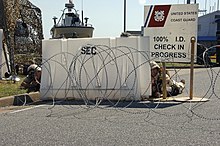Force protection

Force protection(FP) is the concept of protecting military personnel, family members, civilians, facilities, equipment and operations from threats or hazards in order to preserveoperational effectivenessand contribute to mission success.[1][2][3]It is used as a doctrine by members ofNATO.[3]
The concept of force protection was initially created after theBeirut barrack bombingsinLebanonin 1983. With itsCold Warfocus toward potential adversaries employing large conventional military forces at the time (e.g., theSoviet Union,etc.), theU.S. militaryhad become complacent and predictable with regard to asymmetric attacks by state and non-state actors employing terrorist and guerilla methodologies[citation needed].As a result, during what were ostensibly peacekeeping operations by a U.S. Marine Corps landing force ashore in Lebanon in 1983, two explosives-laden civilian trucks were able to breach the perimeter of the Marines' containment area and detonate thecar bombsadjacent to the Marines' billeting areas.
Force protection was subsequently implemented throughout the Defense Department (and later adopted by the Coast Guard) to ensure that such a scenario never happened to U.S. forces again. Force protection itself is characterized by changing protective tactics to avoid becoming predictable.[4]
See also
[edit]- Pentagon Force Protection Agency
- Maritime Force Protection Unit
- United States Air Force Security Forces
- Force Protection Condition
- Base defense operations center
- Quick reaction force
- RNZAF Force Protection
- Force Protection Inc
References
[edit]- ^"Force Protection".Commander, Navy Installations Command.Retrieved14 August2021.
- ^"DOD Dictionary of Military and Associated Terms, November 2019"(PDF).Archived fromthe original(PDF)on 2020-02-18.Retrieved2020-01-03.
- ^ab"Allied Joint Doctrine for Force Protection"(PDF).Ministry of Defence.Retrieved14 August2021.
- ^"Guided Discussion - Force Protection"(PDF).Archived fromthe original(PDF)on 2015-11-23.Retrieved2015-11-10.
